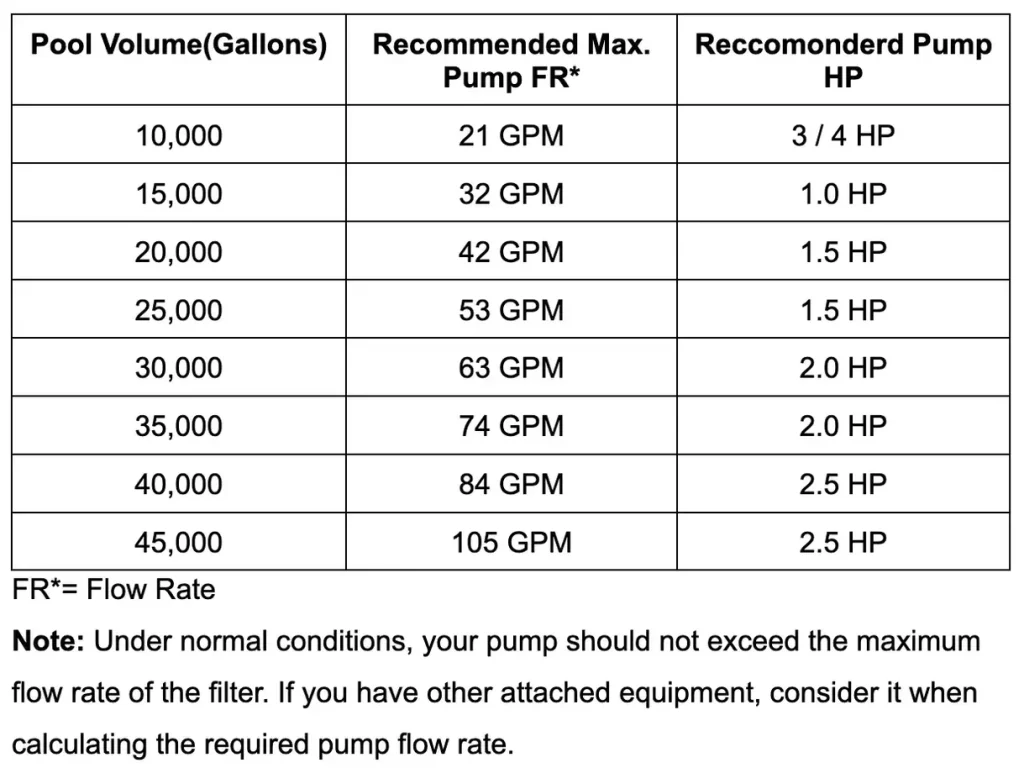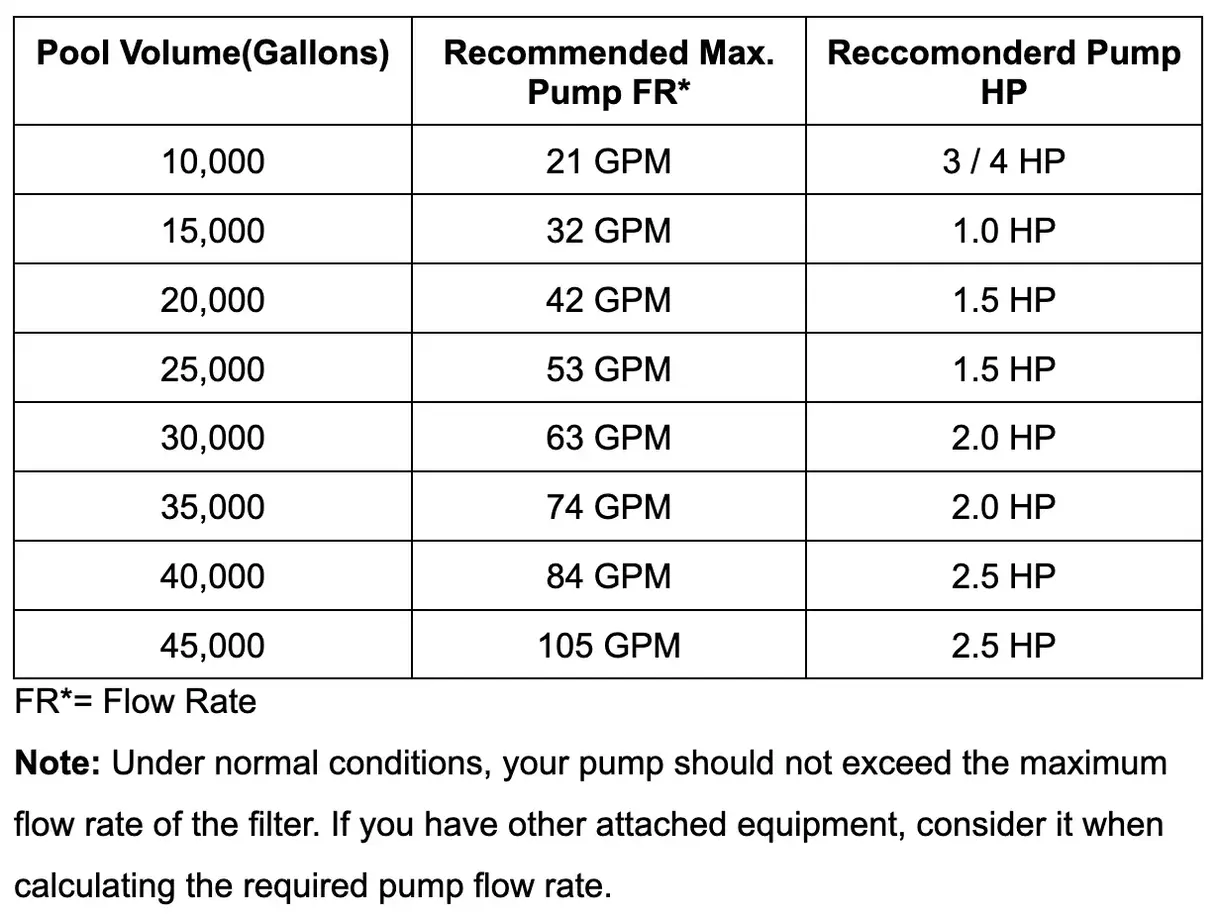(Sizes & Chart) What Size Pool Pump Do I Need For My Pool?
By MIKE DEVID
What Size Pool Pump Do I Need? This is the most common question for customers who want to buy a new pool or replace the old pool pump. Why? Because,
Most people think “The Bigger the Better!” But this is not true for pool pumps. It can cause serious problems. If bought a small one, it may be unable to keep up with the requirements, resulting in cloudy-green water.
Related Article: What Size Pool Filter Do I Need?
The pump must be the correct size for your pool to ensure the filter system works well. So,
What Size Pool Pump Do I Need?
Generally, aim for a pool pump that can filter all the water in your pool within eight hours. Avoid buying a pump that’s larger than necessary to prevent higher operating costs and overpowering your filter system.
Quick Answer: Pool Pump Size Chart

These are the ideal pump sizes. To determine the right pool pump, you need to calculate some other factors too.
But how can you tell if your filter is cycling all the water within the required time? To determine this, you’ll need to do some calculations and know some terms like Pool Volume, GPM, Filter Flow Rate, Turnover Rate, Head Resistance, and Flow Chart.
We’ve simplified the process for you.
Steps To Select the Right Pool Filter Size
How To Choose The Right Pool Pump Size For A Pool?
Figuring out the right size for your pump isn’t hard, but it requires some careful calculations. Follow these step-by-step instructions to determine the exact pump size your pool requires.
1. Calculate The Pool Water Volume
Industry Golden Rule: For optimal water clarity, it’s crucial to circulate and filter the entire pool volume three times within 24 hours. This guarantees that 90% of the pool water undergoes filtration at least once within this timeframe.
Below are the formulas to calculate your pool volume based on its shape:
NOTE: All the measurements in Feet & One cubic foot equals 7.48 gallons
1. Rectangular or Square Pool:
Length × Width × Depth × 7.5 = Pool Volume (Gallons)
2. Round or Circular Pool:
3.14 × (Radius)² × Depth × 7.5 = Pool Volume (Gallons)
3. Oval Pool:
3.14 × Length × Width × 0.25 × Depth × 7.5 = Pool Volume (Gallons)
Once you’ve determined your pool volume, you can calculate how much water needs to be filtered per minute to completely filter all the water within 8 hours.
Percentage of pool volume filtered in each turnover:
63% – 1st
86% – 2nd
95% – 3rd
98% – 4th
TIP: You can use ChatGPT to know the exact volume of your pool.
2. Calculate Required Turnover Rate
Turnover is the minimum amount of time needed to circulate all the water through the pool filter.
Example:
Suppose you have a pool with a volume of 20,000 gallons and you need to turn over all volume within 8 hours accounting for standards. So,
20000/8×60(Minutes)= 41.67 Gallons Per Minute
So, Your GPM=42 for 20,000 gallons of water pool.
3. Calculate Dynamic Head Resistant
Medium Head Pumps are for systems with low resistance, like pools with simple setups and nearby equipment.
High Head Pumps are for systems with high resistance, like pools joined with many equipment or distant equipment.
For plumbing, medium head pumps can use 1½” PVC, while high head pumps need 2″ PVC or larger. Ensure pump connections match filter sizes.
For pipe size considerations:
- 1.5-inch intake line allows a maximum flow rate of 42 GPM
- 2-inch intake line allows a maximum flow rate of 73 GPM
- 2.5-inch intake line allows a maximum flow rate of 120 GPM
- 3-inch intake line allows a maximum flow rate of 160 GPM
So, even if your pump can move 100 gallons per minute, using a 2-inch pipe limited to 73 gallons per minute can strain your system and damage your pump.
NOTE: Each pump comes with a flow chart indicating how much the flow rate decreases with increased pipe length and height. Follow this chart to determine the actual maximum flow rate of the pump.
4. Determine Filter’s Maximum Flow Rate
The filter’s maximum flow rate is the number of gallons of water the filter can move per minute at its maximum filtering capacity.
You can check the maximum flow rate of the filter in the user manual or on the information plate attached to the filter itself.
IMPORTANT: Make sure the pump isn’t too big for the filter. If it is, the motor can overheat or the filter might get damaged. The pump’s GPM should never be higher than the filter’s maximum flow rate. It’s better if the filter is a bit bigger than the pump to avoid flow rate or filtration problems.
The most common filter people buy is a sand filter, which typically has a low filter flow rate. Therefore, you should purchase a pump with a lower flow rate than the maximum flow rate of the sand filter.
5. How Much Horsepower Do I Need?
Did you know? You’ll consider horsepower when buying a pump, but more horsepower doesn’t necessarily mean it’s right for your pool.
You might ask, “How much horsepower do I need?” But horsepower shouldn’t be your first consideration. What matters most is the pump’s flow rate matching your pool’s size, filter, and plumbing. Once you find compatible pumps, you can use horsepower to finalize your choice.
6. Find the Perfect Pump
You’ve completed the calculations to determine the right pool pump size for filtering your pool’s water daily. But before you head to the store, let’s discuss a few other factors to consider.
You have three speed options for your pump:
1. Single Speed Pumps: These pumps operate at a single fixed speed. Some states, such as California and Arizona, have banned them due to their high energy consumption.
2. Dual Speed Pumps: These offer both speeds. Low Speed and High Speed.
3. Variable Speed Pumps: These are more energy-efficient, utilizing magnet motors instead of induction motors like the other types. Magnet motors reduce friction, increasing efficiency, and they’re quieter. Although variable speed pumps cost more at starting, but they save money in the long term.
Conclusion
So, In conclusion, your pool pump’s flow rate should not exceed the filter’s maximum flow rate.
You need to calculate all the necessary data to purchase the perfect pool pump. Avoid buying blindly, as it could cost you more or damage your pump or filter in the long run.
This is all about choosing the right pool pump for the optimal functionality of your pool and its equipment. If you have any questions regarding this, please let us know in the comments, and we’ll try to answer them as soon as possible.

